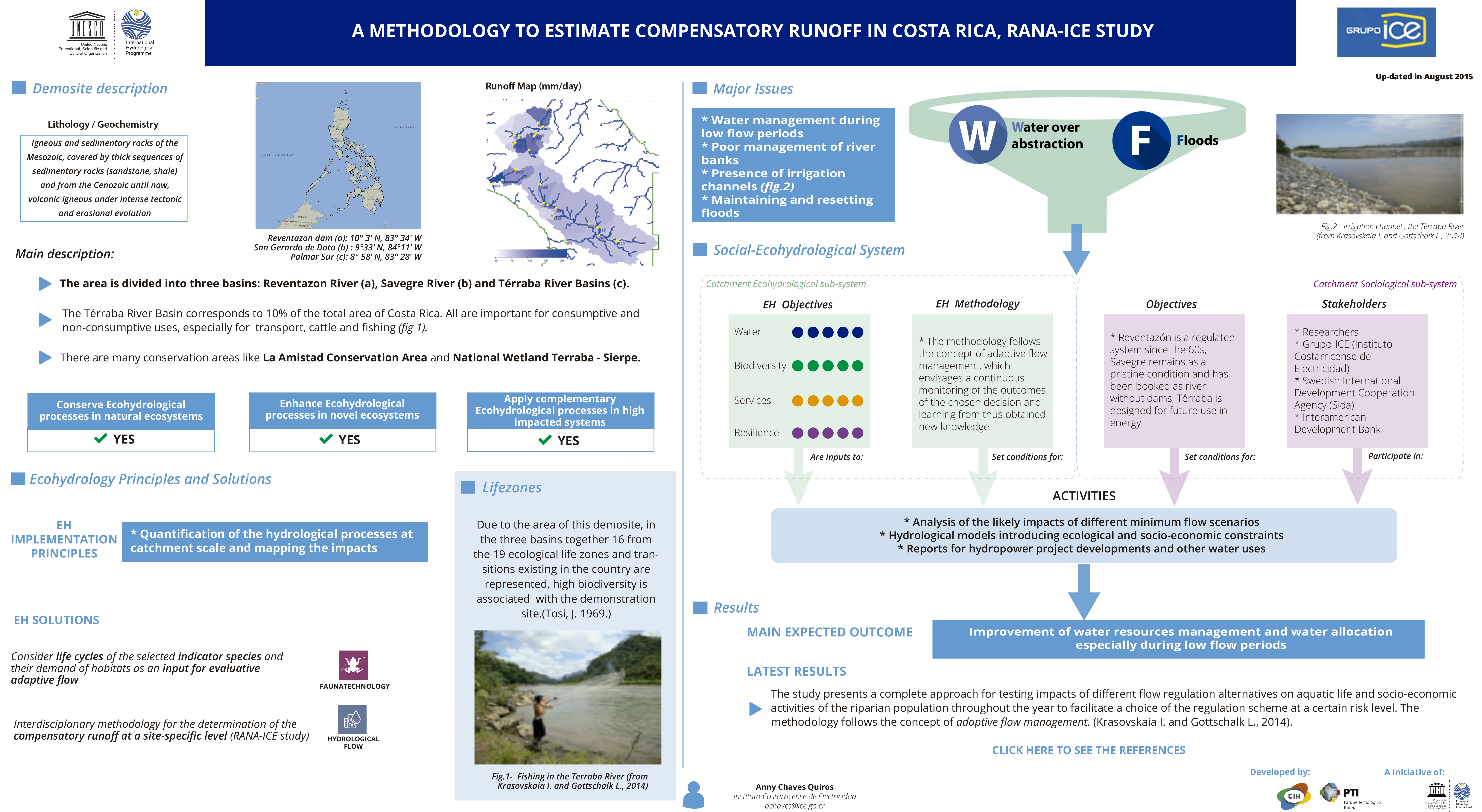A METHODOLOGY TO ESTIMATE COMPENSATORY RUNOFF IN COSTA RICA, RANA-ICE STUDY

Description
Location


Sketch

Information about lithology/geochemistry:
Igneous and sedimentary rocks of the Mesozoic, covered by thick sequences of sedimentary rocks (sandstone, shale) and from the Cenozoic until now, volcanic igneous under intense tectonic and erosional evolution
Main Description
- The area is divided into three basins: Reventazon River (a), Savegre River (b) and Térraba River Basins (c).
- The Térraba River Basin corresponds to 10% of the total area of Costa Rica. All are important for consumptive and nonconsumptive uses, especially for transport, cattle and fishing.
- There are many conservation areas like La Amistad Conservation Area and National Wetland Terraba - Sierpe.
Enhance ecohydrological processes in novel ecosystem
YES
Apply complementary Ecohydrological processes in high impacted system
YES
This table presents the different categories of ecosystem services that ecosystem can provide, divided in:
Provisioning Services are ecosystem services that describe the material or energy outputs from ecosystems. They include food, water and other resources.

Food: Ecosystems provide the conditions for growing food. Food comes principally from managed agro-ecosystems but marine and freshwater systems or forests also provide food for human consumption. Wild foods from forests are often underestimated.

Raw materials: Ecosystems provide a great diversity of materials for construction and fuel including wood, biofuels and plant oils that are directly derived from wild and cultivated plant species.

Fresh water: Ecosystems play a vital role in the global hydrological cycle, as they regulate the flow and purification of water. Vegetation and forests influence the quantity of water available locally.
Regulating Services are the services that ecosystems provide by acting as regulators eg. regulating the quality of air and soil or by providing flood and disease control.

Carbon sequestration and storage: Ecosystems regulate the global climate by storing and sequestering greenhouse gases. As trees and plants grow, they remove carbon dioxide from the atmosphere and effectively lock it away in their tissues. In this way forest ecosystems are carbon stores. Biodiversity also plays an important role by improving the capacity of ecosystems to adapt to the effects of climate change.

Moderation of extreme events: Extreme weather events or natural hazards include floods, storms, tsunamis, avalanches and landslides. Ecosystems and living organisms create buffers against natural disasters, thereby preventing possible damage. For example, wetlands can soak up flood water whilst trees can stabilize slopes. Coral reefs and mangroves help protect coastlines from storm damage.
Ecosystem services "that are necessary for the production of all other ecosystem services". These include services such as nutrient recycling, primary production and soil formation.

Habitats for species: Habitats provide everything that an individual plant or animal needs to survive: food; water; and shelter. Each ecosystem provides different habitats that can be essential for a species’ lifecycle. Migratory species including birds, fish, mammals and insects all depend upon different ecosystems during their movements.

Maintenance of genetic diversity: Genetic diversity is the variety of genes between and within species populations. Genetic diversity distinguishes different breeds or races from each other thus providing the basis for locally well-adapted cultivars and a gene pool for further developing commercial crops and livestock. Some habitats have an exceptionally high number of species which makes them more genetically diverse than others and are known as ‘biodiversity hotspots’.
Cultural Services corresponds nonmaterial benefits people obtain from ecosystems through spiritual enrichment, cognitive development, reflection, recreation, and aesthetic experiences.

Recreation and mental and physical health: Walking and playing sports in green space is not only a good form of physical exercise but also lets people relax. The role that green space plays in maintaining mental and physical health is increasingly being recognized, despite difficulties of measurement.

Tourism: Ecosystems and biodiversity play an important role for many kinds of tourism which in turn provides considerable economic benefits and is a vital source of income for many countries. In 2008 global earnings from tourism summed up to US$ 944 billion. Cultural and eco-tourism can also educate people about the importance of biological diversity.

Aesthetic appreciation and inspiration for culture, art and design: Language, knowledge and the natural environment have been intimately related throughout human history. Biodiversity, ecosystems and natural landscapes have been the source of inspiration for much of our art, culture and increasingly for science.

Spiritual experience and sense of place: In many parts of the world natural features such as specific forests, caves or mountains are considered sacred or have a religious meaning. Nature is a common element of all major religions and traditional knowledge, and associated custos are important for creating a sense of belonging.
Lifezones

![]()
PPT(mm/yr): 1.0
![]()
T(ºc): 1.0
| Elevation of demosite: | 0.0 meters above sea level |
| Humidity: | Semiparched |
| PETr (by year): | 0.01 |
EH Principles
Quantification of the hydrological processes at catchment scale and mapping the impacts
ECOHYDROLOGY ENGINEERING SOLUTIONS
Consider life cycles of the selected indicator species and their demand of habitats as an input for evaluative adaptive flow.
 Faunatechnology
Faunatechnology
Interdisciplanary methodology for the determination of the compensatory runoff at a site-specific level (RANA-ICE study).
 Hydrological Flow
Hydrological Flow
Major Issues
- Water management during low flow periods.
- Poor management of river banks.
- Presence of irrigation channels (fig.2).
- Maintaining and resetting floods.




Expected Outcomes
Improvement of water resources management and water allocation especially during low flow periods.
Latest Results
- The study presents a complete approach for testing impacts of different flow regulation alternatives on aquatic life and socio-economic activities of the riparian population throughout the year to facilitate a choice of the regulation scheme at a certain risk level. The methodology follows the concept of adaptive flow management. (Krasovskaia I. and Gottschalk L., 2014).
Contacts
Anny Chaves Quiros
- achaves@ice.go.cr
- www.grupoice.com
- Instituto Costarricense de Electricidad
- www.grupoice.com

Social ecohydrological system
EH Objectives
EH Methodology
Catchment Ecohydrological sub-system
Objectives
Stakeholders
Catchment Sociological sub-system
Activities